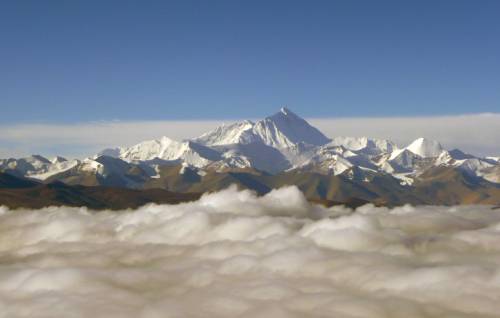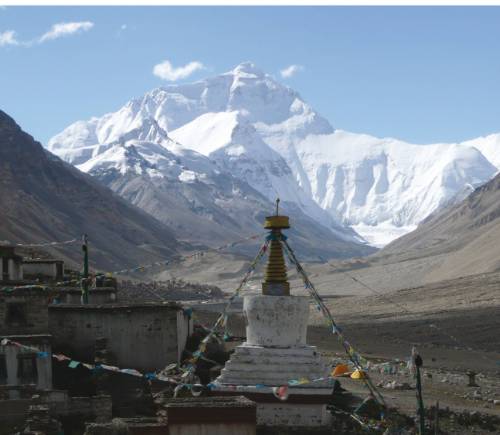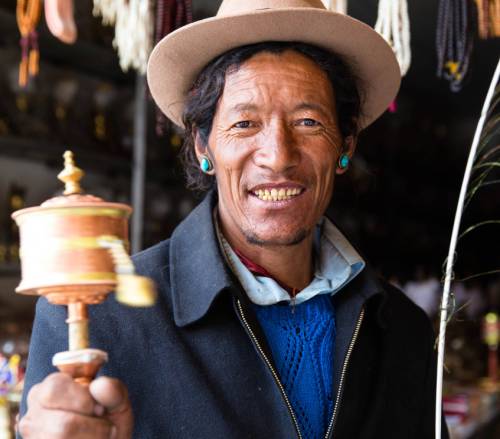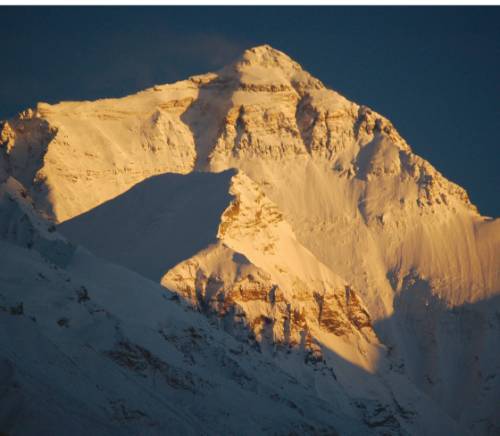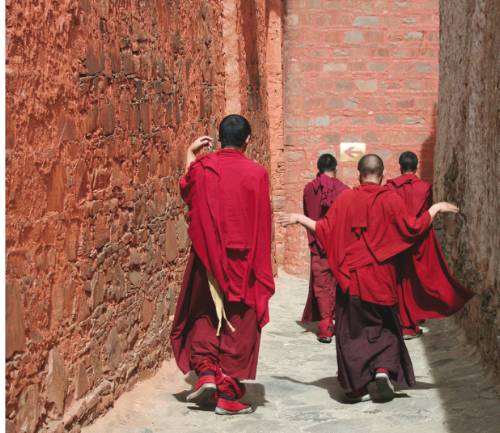Everest Kangshung Face
Everest Kangshung Face
$8150
Everest Kangshung Face
22 Days Starting in Chengdu, China and ending in Kathmandu, Nepal
Visiting: Chengdu, Lhasa, Gyantse, Shigatse, Kharta Valley, Kharta, Kama Valley, Kangshung Face, Chamdo, Langma La, Rongbuk, Rongbuk Monastery, Kyirong, Kathmandu
Tour operator:
Tour code:
KAN
Guide Type:
Fully Guided
Group size:
5 - 12
Tour operated in:
EnglishTrip Styles:
Interests:
Activities:
Tour Overview
Journey deep into the heart of Tibet on an extraordinary trek to the remote Kangshung Face of Everest, one of the most breathtaking and least-visited viewpoints of the world’s highest mountain. Travel across the vast Tibetan Plateau, immersing yourself in the unique culture of Lhasa, Gyantse, and Shigatse, and visit the iconic Potala Palace, the former home of the Dalai Lama.
After time acclimatising in Lhasa, we drive to Kharta, a bustling Tibetan village set against the dramatic backdrop of Everest. From here, our nine-day trek through the stunning Kharta Valley takes us far from the crowds, across two high passes over 5000m (16,404ft), including the Langma La at 5330m (17,486ft), revealing incredible views of Makalu and the mighty Himalaya. Our fully supported camping trek ensures you travel in comfort, with three nourishing meals a day, expert local guides, and built-in acclimatisation days for a safe and rewarding experience.
After the trek, we journey to Rongphu Monastery, near the iconic Everest Base Camp in Tibet, to take in the sheer scale of the North Face of Everest. The adventure continues as we traverse the Himalaya, descending into Nepal via the stunning Langtang region, before concluding in Kathmandu.
World Expeditions was the first company to offer treks in Tibet, and with decades of experience in the Himalaya, our safety-first approach, carefully considered acclimatisation itinerary, and deep cultural connections ensure an immersive and unforgettable journey. Whether you’re drawn by the adventure, the history, or the incredible landscapes, this is a rare opportunity to experience Tibet at its most authentic.
Highlights
Itinerary
Day 1 : Arrive Chengdu, China
Location: Chengdu
Accommodation Name: Buddha Zen Hotel or similar
You will be met by a representative of World Expeditions and transferred to the hotel. Remainder of the afternoon/evening at leisure. Overnight: Buddha Zen Hotel or similar
Day 2 : Fly Chengdu to Lhasa (3,670m)
Location: Lhasa
Accommodation Name: Kyichu Hotel, Dekang Hotel Lhasa or Tarui Pozhang Hotel or similar
This morning we are transferred to the airport for the flight to Lhasa. You will be advised which flight to book as the group are required to arrive into Tibet together due to the group permit. On arrival at Lhasa Airport you will be transferred to the city – a drive that takes around two hours. Due to the high altitude, you need to take it easy when you arrive in Lhasa. (Chengdu to Lhasa flights not included in trip cost.) A briefing will be given around 5pm by your guide, where arrangements will be made for the distribution of your kit bag, sleeping bag and down/fibrefill jacket. Drive: 65km, ~2hrsAltitude: 3,670mOvernight: Kyichu Hotel, Dekang Hotel Lhasa or Tarui Pozhang Hotel or similar
Day 3 - 4 : In Lhasa (3,670m)
Location: Lhasa
Accommodation Name: Kyichu Hotel, Dekang Hotel Lhasa or Tarui Pozhang Hotel or similar
The following two days are scheduled to appreciate the long and rich cultural history of Lhasa. We include visits to the Jokhang, the Norbulingka (the Summer Palace of the Dalai Lama), and the famous Potala Palace. We also include visits to the nearby monasteries of Drepung and Sera. The Jokhang The Old City of Lhasa was built around the Jokhang, the most sacred temple in Tibet. Drive: N/AAltitude: 3,670mOvernight: Kyichu Hotel, Dekang Hotel Lhasa or Tarui Pozhang Hotel or similar
Day 5 : Drive to Gyangtse via the Khamba Pass (4,900m) and Karo La (5,200m).
Location: Gyantse
Accommodation Name: Gyantse Hotel or similar
From Lhasa we drive down the Kyichu Valley to the Yarlong Tsampo (Brahmaputra) before ascending to the Khamba Pass (4,900m). The views are outstanding – in the foreground is the vast freshwater Yamdrok Tso or Turquoise Lake, while to the south the snow-capped ranges merge with the main Himalayan range. We drive around the lake before crossing the Karo La (5,200m) to reach Gyantse. The town is strategically located in the Nyang Chu valley on the ancient trade routes from the Chumbi Valley, Yatung and Sikkim, which met here.Note: while we endevour to stick to the projected itinerary, travel in Tibet is by nature unpredictable and a flexible approach is always needed. Drive: 7-8hrsAltitude: 3,977mOvernight: Gyantse Hotel or similar
Day 6 : In Gyangtse, drive to Shigatse (3,845m)
Location: Shigatse
Accommodation Name: Wanrun Gardan Hotel, Gesar Hotel Shigatse, Shiga Yangcha Hotel or similar
Gyantse is a remarkable place that has escaped much of the Chinese influence evident in other major Tibetan towns. It is dominated by the ancient fort that was besieged by British forces in 1904 during the famous Younghusband Expedition. We also visit the remarkable octagonal chorten, the Kumbum (or Pango Chorten)- built in 1444 on a series of four levels, each of which contains separate chapels. In the afternoon we drive to Shigatse. Drive: 2hrsAltitude: 3,845mOvernight: Wanrun Gardan Hotel, Gesar Hotel Shigatse, Shiga Yangcha Hotel or similar
Day 7 : In Shigatse then drive to Shegar (4,330m)
Location: Shigatse
Accommodation Name: Everest Hotel or similar
In Shigatse we visit the famous Tashilhunpo Monastery, founded in 1447 by the 1st Dalai Lama. Since the time of the 5th Dalai Lama in 1642, the abbot of Tashilhunpo has been known as the Panchen Lama (literally the 'Great Scholar ). Over the generations, the Panchen Lama became established as the chief spiritual and temporal adviser of the huge western portion of Tibet known as Tsang, and at times was even considered a rival to the Dalai Lama. During the Cultural Revolution much of the Tashilhunpo and the nearby fort were destroyed, and what we see today is a huge complex in various stages of rebuilding. Of particular interest are the huge temple to the Maitreya Buddha (the 'Buddha to Be ); the tomb of the 10th Panchen Lama (who died in 1989), which is said to be encased with over 300kg of gold; the Palace of the Panchen Lama; and the tomb of the 5th to 9th Panchen Lamas. The latter, recently reconstructed, contains the remains of the former Panchen Lamas that were retrieved after their separate tombs were demolished by Chinese troops in 1966. Also of interest is the main Assembly Hall, adjacent to many of the important chapels that are in everyday use. Later in the day we drive to Shegar.Drive: 5-6hrsAltitude: 4,330mOvernight: Everest Hotel or similar
Day 8 : Drive to the Kharta Valley (3,690m)
Location: Kharta Valley
Accommodation Name: Tented camp
From Shegar we divert from the main highway and drive south towards the Everest region. From the top of Pang La (5,150 metres) we gain views of Everest and the lie of the surrounding country. From the pass we descend to the village of Phadhruchi where the jeep track divides - the track to the west heading to the Rongbuk Valley - the one to the east leading to the (Phung Chu) Arun Valley and the village of Kharta - the administrative headquarters of the region. We camp at the nearby village of Yuba. Drive: ~7hrsAltitude: 3,690mOvernight: Tented camp
Day 9 : Commence trek to Dhampu (4,300m)
Location: Kharta
Accommodation Name: Tented camp
From Yuba (3,690m) we follow the jeep trail along the banks of the Kharta River. At the end of the jeep road we cross a substantial bridge and follow a well defined trail that gradually winds above a series of small scattered settlements set amid barley fields. Two to three km above the bridge the trail splits. The lower trail continues up valley eventually diverting to the Langma La, while we follow the upper trail that ascends steeply in places towards the valley leading to the Shao La. There are good views back down the valley towards our camp and the Kharta district and the snow capped ridges to the east. In particular we can appreciate the forested hillside to the south of Kharta village that marks the upper limit of the monsoon. En route to camp we may pass villagers laden with planks of wood that have been carried from the Kama Valley. Our first camp is on a grassy meadow known as Dhampu (4,300m) - the first of many magnificent alpine camps. Trek: ~4hrsAltitude: 4,300mOvernight: Tented camp
Day 10 : Trek Dhampu to base of Shao La (4,700m)
Location: Shigatse
Accommodation Name: Tented camp
The first few km on this stage is hard going across a large boulder field. The trail ascends a series of 'glacial steps' before reaching a series of glacial lakes at the head of the valley located at the base of the Shao La (4,700m). Trek: ~4hrsAltitude: 4,700mOvernight: Tented camp
Day 11 : Trek base of Shao La to Joksam (4,030m)
Location: Kama Valley
Accommodation Name: Tented camp
An early start is imperative to ascend the Shao La (4,970m) and gain our first views of Everest (8,848m), Makalu (8,475m) and Lhotse (8,501m). From the pass there is a steady descent to yak pastures before a steeper descent to the valley floor and the trail on down to the Kama Valley. The rocky trail makes this stage quite demanding on the knees as it winds down through birch groves and dwarf rhododendrons to the camp at Joksam (4000 metres). This is an idyllic camp, situated amid pine and fir forests just above the Kama Valley. This change of vegetation reflects the monsoonal influence and summer rains that surge up the nearby Arun Valley throughout the summer months. Trek: ~5hrsAltitude: 4,030mOvernight: Tented camp
Day 12 : Joksam to Alpine Camp (4,470m)
Location: Kangshung Face
Accommodation Name: Tented camp
From the valley floor there is a steep 300 to 400 metre ascent through the conifer forest to a ridgeline high above the Kama Valley. Here we gain magnificent views south towards the Arun Gorge and Nepal. Our trail then crosses alpine ridges that support the summer camps of yak herders' from Kharta village. We also pass a series of beautiful lakes before ascending a ridge and gaining our first uninterrupted views of the Kangshung Face of Everest. We camp in one of the idyllic meadows. Trek: ~5hrsAltitude: 4,470mOvernight: Tented camp
Day 13 : Camp to Pathang (4,550m)
Location: Chamdo
Accommodation Name: Tented camp
Depending on the selection of the camp it will take just a matter of hours to descend to the camp at Pathang (4,550m), a beautiful meadow camp beneath the impressive peak of Chomo Lonzo (7,790m). Options are available to ascend to the sacred lake immediately above the camp. The trail heads up the hillside to the north and it takes about 40 minutes to reach the lake. At the far end of the lake is Sacred Cave carved out of the hillside which is said to be one of the many places where the sage Padmasambhava meditated during his journeys through Tibet. Within the cave are a number of simple shelters and prayer rooms where offerings are made by the occasional pilgrim. Trek: ~3hrsAltitude: 4,550mOvernight: Tented camp
Day 14 : Trek to Pethang Ringmo (Kangshung Face Base Camp) (5,200m)
Location: Kangshung Face
Accommodation Name: Tented camp
From Pathang the trail heads across the meadow before ascending across a loose scree slope. The climb up and across the scree slopes is tiring and it is good to get back onto the more established shepherd trails. Rounding the hillside the Kangshung Face of Everest comes again into view, while across the valley the impressive glaciers at Chomo Lonzo can also be appreciated. Return to Pathang for overnight camping.Trek: ~8hrsAltitude: 4,550mOvernight: Tented camp
Day 15 : Pathang to base of Langma La (5,320m)
Location: Langma La
Accommodation Name: Tented camp
The trail from Pathang heads back down the valley before diverting north towards the Langma La. It leads gradually across the yak pastures and en route we gain views of the summit of Makalu. Our camp at Shurimo is located at the base of the pass. Trek: ~5hrsAltitude: 4,800mOvernight: Tented camp
Day 16 : Cross Langma La to Shomak Lhe (5,370m)
Location: Langma La
Accommodation Name: Tented camp
The climb to the Langma La takes two hours. From camp we climb a well graded trail with further views of Everest, Lhotse, and Makalu. From the pass (5,330m) there is a steep descent to the valley floor. As the valley opens out we pass yak herders' camps from Kharta and the nearby villages. Here there is no shortage of fine campsites. Trek: ~7hrsAltitude: 4,230mOvernight: Tented camp
Day 17 : Drive to Rongbuk (5,000m)
Location: Rongbuk
Accommodation Name: Rongbuk Guesthouse or similar
From Shomak Lhe we drive back to the village of Phadhruchi before continuing onto the Rongbuk Valley. Rongbuk Monastery is situated 15km below the base camp and was reconstructed after the excesses of the Cultural Revolution in the 1960's. From our camp here we gain unrivalled views of the North Face of Everest. At Rongphu we stay in the small lodge attached to the monastery, which has recently been reconstructed following the excesses of the Cultural Revolution in the 1960s. Nowadays there are about twenty monks in attendance.Drive: 8-10hrsAltitude: 5,000mOvernight: Rongbuk Guesthouse or similar
Day 18 : Rongbuk Monastery then drive to Tingri (4,300m)
Location: Rongbuk Monastery
Accommodation Name: Snow Leopard Guest House or similar
Access to Everest Base Camp used by the famous interwar British expeditions is currently restricted to mountaineers with the necessary permits. That said the view of Everest from the monastery is definitely worth the trip as it dominates the valley carved by the glacier originating from the mountains northern flank. In the afternoon we will commence our drive to Kathmandu, stopping to overnight in the small remote town of Tingri.Drive: 5-6hrsAltitude: 4,300mOvernight: Snow Leopard Guest House or similar
Day 19 : Drive to Kyirong (4,130m)
Location: Kyirong
Accommodation Name: Kouan Hotel or similar
Continue our drive to Kathmandu. Today we are heading for the border town of Kyirong. Following the 2015 earthquake the former friendship highway was badly damaged resulting in its continued closure. This new route was opened initially to ensure that trade between Nepal and China could continue. In 2017 the border post was opened to tourists allowing for travel along this legendary overland route to recommence. This road is sure to add to the sense of adventure as it traverses parts of both Tibet and Nepal new to tourism. Road conditions along this route are changeable as improvements to the road continue to ensure that it can accommodate the traffic using it. Drive: 4-5hrsAltitude: 4,130mOvernight: Kouan Hotel or similar
Day 20 : Drive Kyirong to Kathmandu
Location: Kyirong
Accommodation Name: Radisson Hotel
Today we cross the border into Nepal and complete the final stage of our journey from Lhasa via the Langtang region. It is a fitting conclusion to an epic overland journey and the comfort of the Radisson Hotel in Kathmandu will no doubt be welcomed with open arms. Drive: 160km, ~6hrsAltitude: 1,400mOvernight: Radisson Hotel
Day 21 : In Kathmandu
Location: Kathmandu
Accommodation Name: Radisson Hotel
Today you have a full day at leisure to explore Kathmandu’s bustling streets and significant landmarks. You may wish to start by exploring the city’s two most important World Heritage Listed spiritual sites: Pashupatinath, Nepal’s most sacred Hindu temple and an important cremation site; and Boudhanath, the largest Buddhist stupa in Nepal and the most sacred Tibetan Buddhist shrine outside of Tibet. Alternatively you could wander through the markets and shops of the busy Thamel precinct or explore some more of the city’s significant sites such as Swayambhunath (Monkey Temple) or the World Heritage Listed plazas of Patan, Bhaktapur or Durbar Square.Drive: N/AAltitude: 1,400mOvernight: Radisson Hotel
Day 22 : In Kathmandu, trip concludes
Location: Kathmandu
After breakfast you will be transferred to the airport. Trip concludes.
What's Included
-
Airport Transfers
Airport transfers in Chengdu, Lhasa, and Kathmandu are included.
-
Expert Guide
An expert bilingual guide is provided throughout the tour.
-
Trek Pack
The use of a World Expeditions trek pack, including a quality sleeping bag, down or fibre fill jacket, and insulated mat, is included.
What's Not Included
-
International flights
-
Chengdu-Lhasa flight. Please contact your local World Expeditions office to arrange your flights.
-
Meals not included in the daily itinerary
-
Alcoholic and bottled drinks
-
Items of a personal nature such as phone calls, laundry, etc
-
Tips
-
Airport & departure taxes
-
Visas
-
Travel insurance
Mode of Transport
Private transportation is provided throughout the tour, including airport transfers in Chengdu, Lhasa, and Kathmandu. The tour also includes a flight from Chengdu to Lhasa, and yaks are used to carry group equipment during the trek.Accommodation
Experience a mix of comfort and adventure with 2 nights at the Radisson Hotel in Kathmandu, and basic hotels and lodges in Lhasa, Shegar, and Shigatse. As you travel west through Tibet, accommodations become more basic, with multi-share rooms and shared bathroom facilities in some lodges.What You Carry
In your daypack you will need to carry extra warm clothing (depending on the altitude, location and weather), a rainjacket, water bottle, camera gear, valuables and personal items such as sunscreen, lip-eze etc. Porters and/or yaks carry all group gear.Grading
Check out our Q&As
-
What kind of transportation is provided during the tour?
Private transportation is provided throughout the tour, including airport transfers in Chengdu, Lhasa, and Kathmandu. The tour also includes a flight from Chengdu to Lhasa, and yaks are used to carry group equipment during the trek.
-
What type of accommodation can I expect during the tour?
Accommodation includes 2 nights at the Radisson Hotel in Kathmandu. As you travel further west through Tibet, the accommodation becomes more basic, with stays in basic hotels and lodges in Lhasa, Shegar, and Shigatse. There may be times when it is necessary to stay in very basic lodges with multi-share rooms and shared bathroom facilities.
-
Are meals included in the tour package?
The tour includes 21 breakfasts, 16 lunches, and 15 dinners, with all meals on the trek valued at US$530.
-
What equipment is provided for the trek?
The tour provides a World Expeditions trek pack, which includes a quality sleeping bag, a down or fibre fill jacket, and an insulated mat valued at over US$500. Additionally, a souvenir World Expeditions 80l kit bag is provided.
-
What safety measures are in place for high altitude trekking?
For safety, the tour includes a group medical kit, bottled oxygen for emergency use, and a portable altitude chamber for group use.
-
What cultural sites will be visited in Lhasa?
In Lhasa, the tour includes visits to the Jokhang, the Norbulingka (the Summer Palace of the Dalai Lama), the famous Potala Palace, and the nearby monasteries of Drepung and Sera.
-
What is the level of physical fitness required for this tour?
This tour is graded as moderate to challenging, requiring a good level of fitness. Days can involve 8-10 hours of strenuous exercise in remote and rugged terrain, with altitudes generally less than 5500 metres. Preparation should include up to one hour of strenuous exercise 4-5 times per week, with bushwalking involving steep ascents and descents.
-
Who will be my travelling companions on the tour?
We have offices on three continents which means your travelling companions will be just that – international and wonderfully eclectic. Part of small group travel means that although travellers come from various locations and backgrounds, you will be travelling with like-minded companions who, like you, are keen to share the experience and forge lifelong friendships.
-
What about environmental impact?
We believe that adventure travel revolves around establishing a strong relationship with the people and environments in which we operate. Our responsible travel policies have been carefully developed to ensure that we minimise the impact of our presence and help to protect the regions we visit while contributing positively to the local community.
-
What should I pack?
Your pre-departure documents include a detailed packing list with items that you need to bring. While most of the equipment for daily activities is included in your tour cost, some items like helmets and hiking boots are best brought from home. The pre-departure documents also include information on layering and recommended brands for various items to ensure you are fully prepared for your trip.
-
Do you operate a “single share” option and how does it work?
Yes. World Expeditions does not require single travellers to pay a surcharge for travelling alone on the vast majority of our trips. Our holidays are primarily on a twin share basis, so if you are joining the group as a solo traveller, we will match you with someone of your own gender. The choice is yours however; if you prefer not to share, we do offer single supplements for private occupancy.
-
Are tips included in my trip price?
Tips are not included in the tour cost. Tipping is a personal thing, do not worry about how much, or when, to tip. Tipping guidelines are provided for certain destinations in our pre departure information upon booking, however the best advice will be provided by your tour leader.
-
Am I suited to small-group travel?
We recognise that many of our travellers have not been on a ‘group trip’ before. Yet what our departures provide is both structure and flexibility, allowing you plenty of freedom within the framework of the itinerary. You’ll find that with our maximum group size at 16, you’ll travel in a minimal impact style with a great group of like-minded travellers.
-
Can you advise which vaccinations are recommended?
While our pre-departure kit provides information on vaccinations, we suggest that you consult your doctor, local government inoculation centre or a travel medical specialist in order to get the most current advice regarding vaccination requirements.
Reviews from travellers on this tour
1 Select your preferred date
Sunday - Sunday
Oct 26, 2025 - Nov 16, 2025Sunday - Sunday
Apr 26, 2026 - May 17, 2026Sunday - Sunday
Oct 25, 2026 - Nov 15, 2026Book with Confidence
-
Transfer as credit for future tours
World Expeditions allows you to transfer existing payments to a future tour to avoid cancellation fees if you can't travel and inform world expeditions, 70 days before departure.
-
Low Deposit
World Expeditions requires a minimum deposit of 400 GBP per person or the full booking value, whichever is less, with the final balance not due until 70 days before departure.
-
Cancellation Policy
We don't charge a cancellation fee, here is a summary of world expeditions charges.
Up to 70 days before tour starts: Forfeit 100% of deposit.
At 69 days before tour starts: Forfeit 50% of booking price.
At 35 days before tour starts: Forfeit 100% of booking price.
